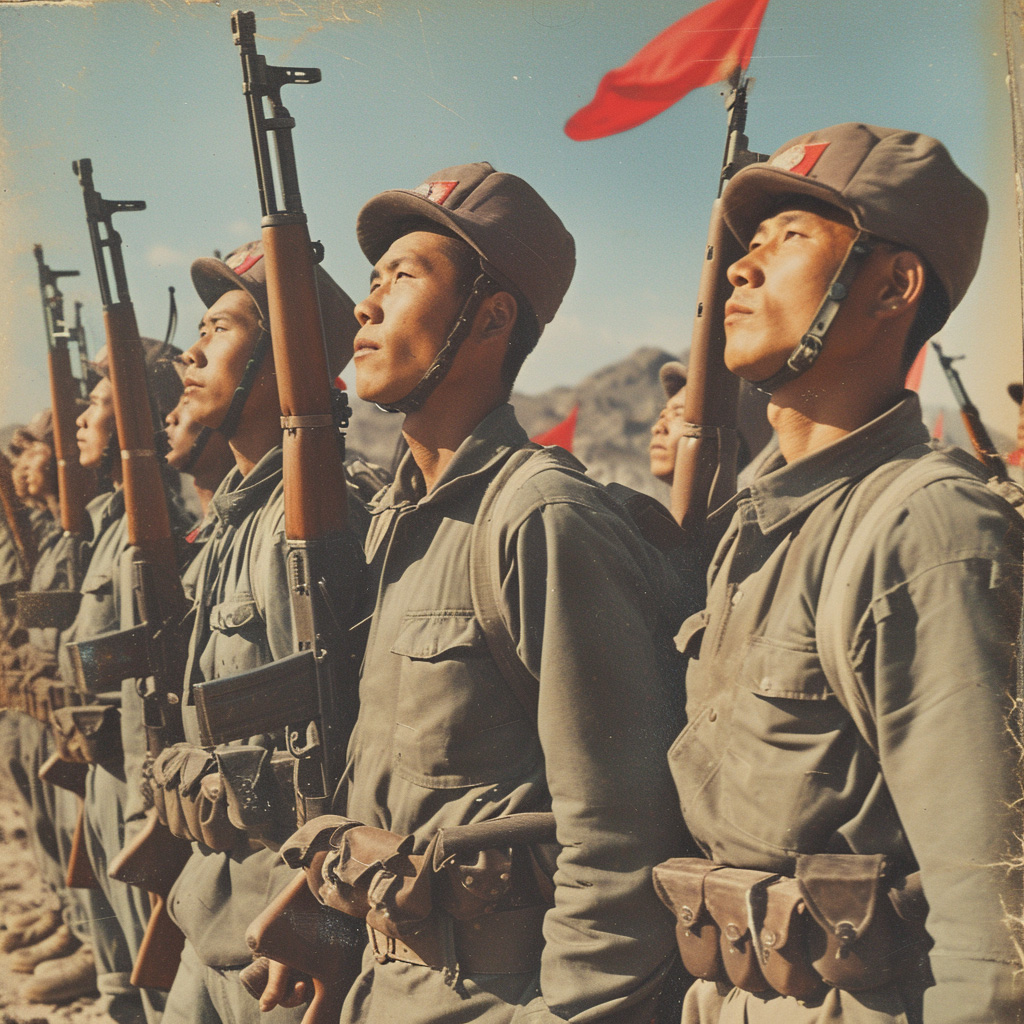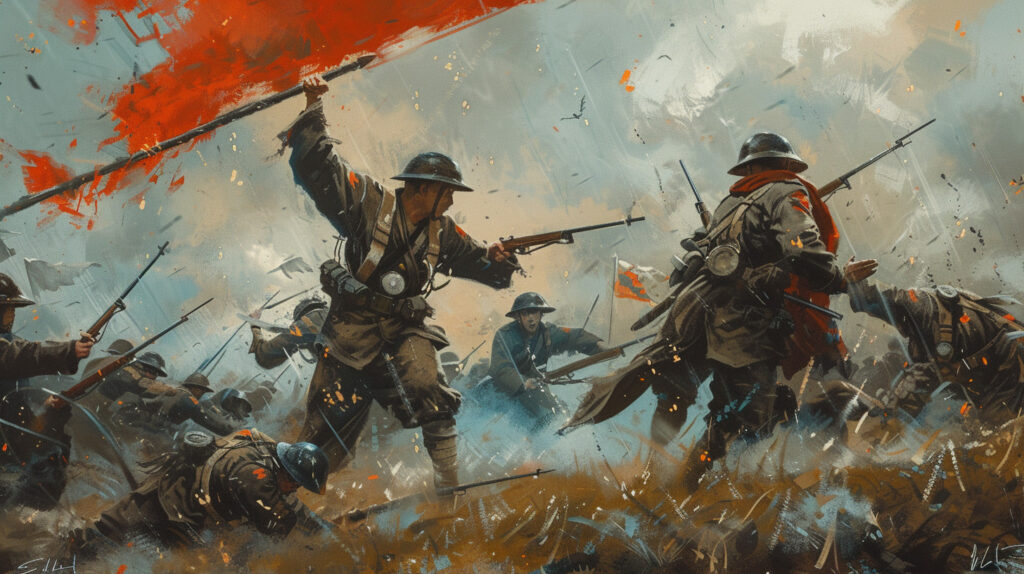The Chinese Civil War (1927-1949) was a pivotal conflict between the Nationalists and Communists. This article explores its causes, key figures, major battles, and lasting impacts.
The Chinese Civil War, spanning from 1927 to 1949, was a defining conflict in China’s modern history. This struggle between the Nationalist Kuomintang (KMT) and the Communist Party of China (CPC) not only shaped the future of China but also had significant implications for global geopolitics. Understanding the causes, key players, significant battles, and lasting consequences of this civil war offers valuable insights into the emergence of modern China.

Reasons for the Chinese Civil War (1927-1949)
The roots of the Chinese Civil War can be traced back to the fragmentation of China in the early 20th century. Following the collapse of the Qing Dynasty in 1912, China was plagued by internal strife and warlordism. The establishment of the Republic of China under the Kuomintang (KMT) led by Sun Yat-sen offered a semblance of unity, but his death in 1925 saw the rise of Chiang Kai-shek, who took over the leadership.
The ideological clash between the KMT and the Communist Party of China (CPC) was central to the conflict. The KMT, influenced by Sun Yat-sen’s Three Principles of the People—nationalism, democracy, and livelihood—sought to unify China under a nationalist government. Meanwhile, the CPC, founded in 1921, aimed to establish a socialist state based on Marxist-Leninist principles. The alliance between the KMT and CPC during the Northern Expedition (1926-1928) to end warlord rule was tenuous and fraught with mutual suspicion.
In 1927, tensions boiled over when Chiang Kai-shek initiated a purge against the communists in Shanghai, marking the beginning of the civil war. This “White Terror” decimated the communist ranks in urban areas and forced the CPC to retreat to rural strongholds, particularly in Jiangxi Province. The ideological divide, combined with power struggles, regionalism, and the broader socio-economic challenges facing China, made the conflict inevitable.
Who Was Involved in the Chinese Civil War (1927-1949)
The primary parties involved in the Chinese Civil War were the Kuomintang (KMT) and the Communist Party of China (CPC). The KMT, led by Chiang Kai-shek, represented the nationalist government seeking to unify China under a centralized state. The KMT had significant military resources, foreign support (notably from the United States), and control over the more industrialized and urban regions of China.
The CPC, under the leadership of Mao Zedong, represented the communist movement aiming to establish a socialist state. The CPC drew substantial support from the rural peasantry, who were disillusioned with the KMT’s corruption and failure to address land reform. The CPC’s strategy relied on guerrilla warfare and establishing rural base areas, with the most notable being the Jiangxi Soviet and later the Yan’an base in Shaanxi Province.
Other significant actors included various warlords who controlled different regions of China, foreign powers such as Japan, which occupied parts of China during the Second Sino-Japanese War (1937-1945), and the Soviet Union, which provided crucial support to the CPC.
The involvement of these diverse groups and the fluctuating alliances throughout the conflict highlighted the complexity of the Chinese Civil War. The KMT’s initial military superiority was challenged by the CPC’s effective mobilization of peasant support and strategic use of guerrilla tactics. The broader geopolitical context, including World War II and the subsequent Cold War, also influenced the dynamics and outcome of the civil war.
The Leaders of the Chinese Civil War (1927-1949)
The Chinese Civil War saw prominent leaders whose strategies and decisions shaped the course of the conflict. Chiang Kai-shek emerged as the leader of the Kuomintang (KMT) following Sun Yat-sen’s death. Chiang, a former military academy commandant, was determined to unify China under the KMT’s nationalist vision. His leadership was marked by efforts to modernize China and consolidate central power, though his regime faced criticism for corruption and failure to address social issues.
Mao Zedong, a founding member of the Communist Party of China (CPC), rose to prominence through his advocacy of rural-based revolution. Mao’s leadership emphasized the mobilization of the peasantry and guerrilla warfare, strategies that proved effective against the KMT’s conventional forces. Mao’s ideological and tactical innovations were crucial in sustaining the CPC through difficult periods, such as the Long March (1934-1935), where the communists retreated to the remote base in Yan’an.
Zhou Enlai, another key communist leader, played a significant role in both military and diplomatic efforts. He was instrumental in maintaining the CPC’s cohesion and negotiating alliances, particularly during the Second United Front against Japanese invasion.
On the KMT side, generals such as Bai Chongxi and Chen Cheng were vital in executing military campaigns against both Japanese forces and the CPC. Despite their efforts, internal divisions and varying strategies within the KMT hindered their effectiveness.
Post-war, Chiang Kai-shek retreated to Taiwan with his government, establishing the Republic of China there. Mao Zedong declared the founding of the People’s Republic of China on October 1, 1949, marking the CPC’s victory and the beginning of his leadership in mainland China.
Was There a Decisive Moment?
The decisive moment in the Chinese Civil War was the breakdown of the Second United Front between the Kuomintang (KMT) and the Communist Party of China (CPC) after World War II. Initially united against the Japanese invasion during the Second Sino-Japanese War (1937-1945), the fragile alliance disintegrated following Japan’s surrender in 1945.
The KMT and CPC vied to control the liberated territories and former Japanese-held areas. Efforts to negotiate peace, mediated by U.S. General George Marshall in 1946, failed as both sides sought to consolidate their power. The resumption of full-scale civil war in 1946 marked the end of any possibility for peaceful resolution and set the stage for the final phase of the conflict. The CPC’s effective guerrilla tactics and growing popular support contrasted with the KMT’s declining morale and rampant corruption, leading to significant communist advances by 1947.
Major Battles of the Chinese Civil War (1927-1949)
- Shanghai Massacre (1927): Also known as the “April 12 Incident,” this was a significant early confrontation where Chiang Kai-shek’s KMT forces purged communists in Shanghai, marking the beginning of open conflict between the KMT and CPC.
- Nanchang Uprising (1927): In response to the Shanghai Massacre, the CPC attempted an uprising in Nanchang, leading to intense battles and marking the start of the CPC’s military resistance.
- Autumn Harvest Uprising (1927): Led by Mao Zedong, this was another early communist revolt in Hunan Province, though it was quickly suppressed, it highlighted the CPC’s shift towards rural-based insurgency.
- Encirclement Campaigns (1930-1934): Chiang Kai-shek launched a series of campaigns to encircle and destroy communist base areas in Jiangxi. The most significant was the fifth campaign, which forced the CPC to undertake the Long March.
- The Long March (1934-1935): This strategic retreat of the CPC from Jiangxi to Yan’an, covering over 6,000 miles, was a defining event. Despite immense losses, it solidified Mao’s leadership and the survival of the communist movement.
- Xi’an Incident (1936): KMT general Zhang Xueliang detained Chiang Kai-shek to force a temporary truce with the CPC, leading to the formation of the Second United Front against Japanese aggression.
- Battle of Pingxingguan (1937): One of the early battles during the Second Sino-Japanese War where CPC forces under Lin Biao ambushed Japanese troops, boosting communist morale.
- Huaihai Campaign (1948-1949): A series of battles in Eastern China where the CPC forces decisively defeated the KMT, capturing key cities and signaling the shift in momentum towards communist victory.
- Liaoshen Campaign (1948): This campaign in Northeast China saw the CPC capture major cities including Shenyang, effectively destroying KMT presence in Manchuria.
- Pingjin Campaign (1948-1949): This campaign led to the capture of Beiping (Beijing) by the CPC, further consolidating their control in Northern China.
Was There a Turning Point?
The Huaihai Campaign (November 1948 – January 1949) is often regarded as the turning point in the Chinese Civil War. This large-scale engagement saw the Communist forces decisively defeat the Nationalist armies in Eastern China. The success of the CPC in this campaign significantly weakened the KMT’s military capabilities and morale. The loss of key territories and the defection of many Nationalist troops to the communists marked a shift in the war’s balance of power. Following this campaign, the CPC rapidly advanced southward, leading to the eventual collapse of Nationalist resistance and the establishment of the People’s Republic of China.

Consequences of the Chinese Civil War (1927-1949)
The Chinese Civil War had profound and lasting consequences for China and the world. The most immediate result was the establishment of the People’s Republic of China (PRC) on October 1, 1949, by the Communist Party of China under Mao Zedong. This marked the beginning of communist rule in mainland China and led to significant political, social, and economic transformations. The Nationalist government retreated to Taiwan, where it continued to claim legitimacy as the Republic of China.
The war caused massive human suffering, with millions of casualties and widespread destruction. It also led to significant shifts in population, including the mass migration of refugees to Taiwan and other regions.
Internationally, the outcome of the Chinese Civil War influenced the geopolitical landscape of the Cold War. The PRC aligned with the Soviet Union, while the United States supported the Nationalists in Taiwan, contributing to the East-West divide. The conflict also affected neighboring countries, influencing revolutionary movements and conflicts in Asia.
Economically, the war and subsequent communist policies, including land reforms and nationalization of industries, fundamentally altered China’s economic structure. These changes laid the groundwork for future economic developments under subsequent leaders.
The Chinese Civil War was a pivotal conflict that reshaped China’s political landscape and had significant global implications. Understanding its causes, key figures, major battles, and outcomes provides a comprehensive view of this transformative period in Chinese history. The war’s legacy continues to influence China’s development and its role in the world.
Back to the Wars section